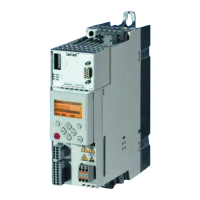8400 StateLine C | Reference manual
Introduction: Parameterising the controller
Device access protection
44 L Firmware ≤ 11.00 - DMS 8.0 EN - 10/2011
2.4.2 Device personalisation
The device personalisation serves to connect the controller to the memory module by
means of a binding ID. If the device personalisation is active, write/read actions between
the controller and the memory module are only executed if both components have
identical binding IDs.
If, for instance, a parameter set has been loaded from the memory module when the device
personalisation was active, this parameter set cannot be saved to another memory module
that has a different binding ID or no binding ID at all.
Hence, a parameter set cannot be copied from a personalised memory module to a
non-personalised memory module!
The following two types are distinguished during the check:
If a different binding ID is detected during switch-on of the controller (during device
initialisation):
– The "Fault" error response is returned.
–The "PS10: Invalid memory module binding
" error message is entered into the
logbook.
If a different binding ID is detected during the execution of a device command for
loading/saving the parameter set:
– The loading/saving process is not carried out.
– A corresponding status for the device command is output in C00003
.
Lenze delivery status: Operation at the customer's site: Impermissible replacement by the
end user:
No binding ID has been set. Customer sets binding ID for device
personalisation purposes.
If device personalisation is active:
A replacement of the controller or
the memory module results in an
error message if the binding ID is
incorrect or not available.

